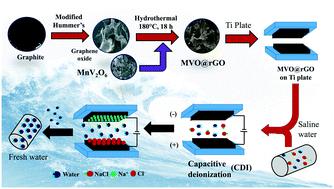当前位置:
X-MOL 学术
›
Environ. Sci.: Nano
›
论文详情
Our official English website, www.x-mol.net, welcomes your
feedback! (Note: you will need to create a separate account there.)
Highly efficient capacitive deionization of brackish water with manganese vanadate nanorod decorated reduced graphene oxide electrode
Environmental Science: Nano ( IF 5.8 ) Pub Date : 2021-09-01 , DOI: 10.1039/d1en00514f Eric R. Halabaso, Jonathan W. L. Salvacion, Eko Prasetyo Kuncoro, Ruey-An Doong
Environmental Science: Nano ( IF 5.8 ) Pub Date : 2021-09-01 , DOI: 10.1039/d1en00514f Eric R. Halabaso, Jonathan W. L. Salvacion, Eko Prasetyo Kuncoro, Ruey-An Doong

|
Capacitive deionization (CDI) utilizing metal oxide-decorated carbon-based materials has emerged as a promising process to convert saline water into freshwater due to its lower energy demand and robustness. In this study, manganese vanadate (MnV2O6) combined with 2-dimensional reduced graphene oxide (MVO@rGO) was synthesized via a hydrothermal method. Results show that the small-sized nanorods of MVO with the aspect ratio of 4–6 can be embedded onto the rGO surface at a hydrothermal temperature of 180 °C for 18 h in the presence of sodium dodecyl sulfate as the stabilizing agent. The as-synthesized MVO@rGO provides excellent electrochemical performance with specific capacitances of 208 and 201 F g−1 at 5 mV s−1 and 2 A g−1, respectively. The MVO@rGO exhibits a high specific surface area of 374 m2 g−1 with a continuous pore size distribution ranging from 2 to 10 nm, which can provide sufficient active sites and channels for ion transport. The low impedance of MVO@rGO also accelerates the ion and electron transport inside the porous structure. Moreover, both electric double layer and faradaic capacitance contribute to the electrochemical performance of MVO@rGO, resulting in superior CDI performance. The symmetric MVO@rGO electrodes show an enhanced salt electrosorption capacity (SEC) of 49.3 mg g−1 at 1.4 V in the 1000 mg L−1 NaCl solution and excellent long-term stability toward salt removal for 50 cycles. The CDI Ragone plot also shows that the SEC is a function of initial NaCl concentration (100–1000 mg L−1) and applied voltage (0.8–1.4 V). The superior electrochemical and CDI performance makes the MVO@rGO a promising electrode material for brackish water desalination and other electrochemical energy storage applications.
中文翻译:

用钒酸锰纳米棒装饰的还原氧化石墨烯电极对苦咸水进行高效电容去离子
由于其较低的能量需求和稳健性,利用金属氧化物装饰的碳基材料的电容去离子 (CDI) 已成为将盐水转化为淡水的有前途的工艺。在这项研究中,钒酸锰 (MnV 2 O 6 ) 与二维还原氧化石墨烯 (MVO@rGO) 相结合,通过水热法合成。结果表明,在十二烷基硫酸钠作为稳定剂的存在下,长径比为 4-6 的小尺寸 MVO 纳米棒可以在 180°C 的水热温度下嵌入 rGO 表面 18 小时。所合成的MVO @ RGO提供的208和201 F G比电容优异的电化学性能-1以5mV小号-1和2 A g -1,分别。MVO@rGO 具有 374 m 2 g -1的高比表面积,连续孔径分布范围为 2 至 10 nm,可为离子传输提供足够的活性位点和通道。MVO@rGO 的低阻抗也加速了多孔结构内的离子和电子传输。此外,双电层和法拉第电容都有助于 MVO@rGO 的电化学性能,从而产生优异的 CDI 性能。对称 MVO@rGO 电极在 1000 mg L -1 中在 1.4 V 下显示出 49.3 mg g -1的增强的盐电吸附容量(SEC)NaCl 溶液,并且在 50 次循环中对除盐具有出色的长期稳定性。CDI Ragone 图还显示 SEC 是初始 NaCl 浓度 (100–1000 mg L -1 ) 和施加电压 (0.8–1.4 V) 的函数。优异的电化学和 CDI 性能使 MVO@rGO 成为微咸水淡化和其他电化学储能应用的有前途的电极材料。
更新日期:2021-09-06
中文翻译:

用钒酸锰纳米棒装饰的还原氧化石墨烯电极对苦咸水进行高效电容去离子
由于其较低的能量需求和稳健性,利用金属氧化物装饰的碳基材料的电容去离子 (CDI) 已成为将盐水转化为淡水的有前途的工艺。在这项研究中,钒酸锰 (MnV 2 O 6 ) 与二维还原氧化石墨烯 (MVO@rGO) 相结合,通过水热法合成。结果表明,在十二烷基硫酸钠作为稳定剂的存在下,长径比为 4-6 的小尺寸 MVO 纳米棒可以在 180°C 的水热温度下嵌入 rGO 表面 18 小时。所合成的MVO @ RGO提供的208和201 F G比电容优异的电化学性能-1以5mV小号-1和2 A g -1,分别。MVO@rGO 具有 374 m 2 g -1的高比表面积,连续孔径分布范围为 2 至 10 nm,可为离子传输提供足够的活性位点和通道。MVO@rGO 的低阻抗也加速了多孔结构内的离子和电子传输。此外,双电层和法拉第电容都有助于 MVO@rGO 的电化学性能,从而产生优异的 CDI 性能。对称 MVO@rGO 电极在 1000 mg L -1 中在 1.4 V 下显示出 49.3 mg g -1的增强的盐电吸附容量(SEC)NaCl 溶液,并且在 50 次循环中对除盐具有出色的长期稳定性。CDI Ragone 图还显示 SEC 是初始 NaCl 浓度 (100–1000 mg L -1 ) 和施加电压 (0.8–1.4 V) 的函数。优异的电化学和 CDI 性能使 MVO@rGO 成为微咸水淡化和其他电化学储能应用的有前途的电极材料。











































 京公网安备 11010802027423号
京公网安备 11010802027423号